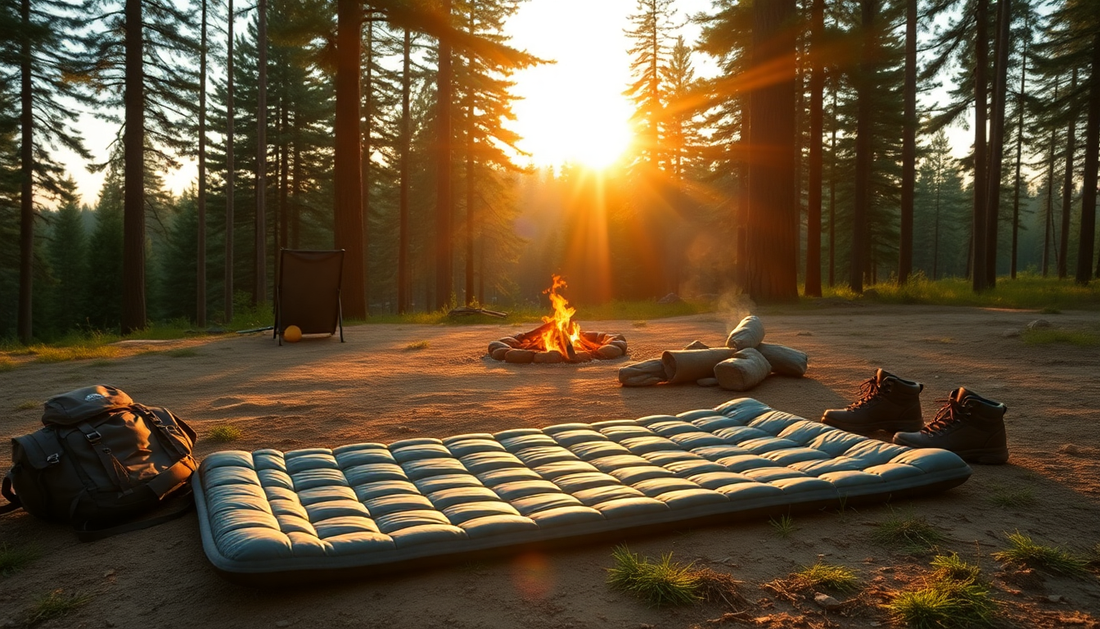
Elevate Your Outdoor Slumber: How to Choose the Perfect Camping Sleeping Pad
Share
Camping is all about immersing yourself in the great outdoors, but a good night's sleep is crucial for making the most of your adventure. That's where the humble camping sleeping pad comes into play. This unsung hero can make the difference between waking up refreshed and ready to tackle the day, or tossing and turning all night.
As an avid camper, I've learned that investing in the right sleeping pad can truly elevate your outdoor experience. Whether you're a seasoned backpacker or a casual car camper, the perfect sleeping pad can mean the difference between a restful night and a miserable one. In this comprehensive guide, I'll share my tips and insights to help you find the ideal camping sleeping pad for your needs.
Understanding the Types of Camping Sleeping Pads
When it comes to camping sleeping pads, there are three main types to consider:

Inflatable Pads
Inflatable pads are a popular choice for their versatility and compact size. These pads are typically made of durable, lightweight materials like nylon or polyester, and can be easily inflated with a few breaths or a small pump. They offer excellent cushioning and insulation, making them a great option for a wide range of camping scenarios.
Self-Inflating Pads
Self-inflating pads combine the convenience of an inflatable pad with the added benefit of built-in insulation. These pads use a special foam core that expands when the valve is opened, allowing the pad to self-inflate. This makes them a great choice for those who want the comfort of an inflatable pad with the added warmth of insulation.
Foam Pads
Foam pads are the simplest and most basic type of camping sleeping pad. They are made of closed-cell foam, which provides a durable and reliable sleeping surface. While they may not offer the same level of cushioning as inflatable or self-inflating pads, foam pads are often more affordable and can be a great option for budget-conscious campers.
Key Factors to Consider When Choosing a Camping Sleeping Pad
Now that you understand the different types of camping sleeping pads, let's dive into the key factors to consider when making your selection:
Thickness
The thickness of your sleeping pad can have a significant impact on your comfort. Generally, the thicker the pad, the more cushioning and insulation it will provide. For backpacking, you'll want to opt for a thinner, more compact pad, while for car camping, you can indulge in a thicker, more luxurious option.
Weight
Weight is a crucial consideration, especially for backpackers. Inflatable and self-inflating pads tend to be lighter than their foam counterparts, making them a better choice for those who need to minimize their pack weight. However, if you're car camping, weight may be less of a concern, and you can prioritize comfort over portability.
Insulation (R-value)
The R-value of a sleeping pad is a measure of its insulating properties. The higher the R-value, the better the pad will be at keeping you warm and insulated from the cold ground. This is particularly important for cold-weather camping or high-altitude adventures.
Comfort Level
Comfort is subjective, but there are some general guidelines to consider. Inflatable and self-inflating pads tend to offer more cushioning and contouring support, while foam pads may be better suited for side sleepers. Pay attention to the materials used, as well as the overall shape and size of the pad.
Durability
Camping can be tough on your gear, so it's important to choose a sleeping pad that can withstand the rigors of the great outdoors. Look for pads made with high-quality, puncture-resistant materials that can stand up to rocks, sticks, and other potential hazards.
Matching Sleeping Pads to Your Camping Style
Not all camping sleeping pads are created equal, and the type you choose should be tailored to your specific camping needs. Here's a quick guide to help you match the perfect pad to your camping style:
Backpacking
For backpacking, you'll want a lightweight, compact pad that won't weigh you down. Inflatable or self-inflating pads are often the best choice, as they offer excellent insulation and cushioning without adding too much bulk to your pack.
Car Camping
When car camping, you have the luxury of more space and weight capacity, so you can opt for a thicker, more comfortable pad. Self-inflating or foam pads are great options, as they provide superior cushioning and insulation without the need to worry about pack weight.
Mountaineering
For high-altitude mountaineering adventures, you'll need a sleeping pad with a high R-value to keep you warm and insulated from the cold ground. Inflatable pads with built-in insulation are often the best choice in these conditions.
Family Camping
When camping with the whole family, you may want to consider a larger, rectangular-shaped pad that can accommodate two or more people. Self-inflating or foam pads are often a good choice, as they provide ample space and comfort for everyone.
Prioritizing Comfort and Personal Preferences
At the end of the day, the perfect camping sleeping pad is the one that best suits your individual needs and preferences. Consider factors like your sleeping position, body type, and personal comfort level to make the best choice.
Some additional factors to keep in mind:
- Size and shape: Make sure the pad is the right size and shape to accommodate your body comfortably.
- Material: Pay attention to the materials used, as they can impact factors like noise level, breathability, and overall comfort.
- Ease of inflation/deflation: For inflatable and self-inflating pads, consider how easy they are to set up and pack away.
Don't be afraid to try out different options and find the one that truly elevates your outdoor slumber. After all, a good night's sleep is the foundation for an unforgettable camping adventure.
Budgeting for the Perfect Camping Sleeping Pad
Camping sleeping pads can range widely in price, from budget-friendly options to high-end, premium models. When setting your budget, consider the following:
Entry-Level Pads
If you're just starting out or on a tight budget, there are plenty of affordable, entry-level camping sleeping pads available. These pads may not offer the same level of comfort or insulation as more expensive options, but they can still provide a decent night's sleep.
Mid-Range Pads
For campers who want a balance of quality and affordability, mid-range sleeping pads are a great choice. These pads often offer better insulation, durability, and comfort than entry-level options, without breaking the bank.
Premium Sleeping Pads
For the ultimate in comfort and performance, premium sleeping pads are worth the investment. These high-end models typically feature advanced materials, superior insulation, and innovative designs to provide the ultimate in outdoor slumber.
Maintaining and Caring for Your Camping Sleeping Pad
To ensure your camping sleeping pad lasts for many adventures to come, it's important to properly maintain and care for it. Here are some tips:
Cleaning
Regularly clean your sleeping pad according to the manufacturer's instructions. This will help remove dirt, debris, and any odors that may have accumulated.
Storage
When not in use, store your sleeping pad in a cool, dry place. Avoid storing it in direct sunlight or in a damp environment, as this can damage the materials.

Repair Techniques
Minor punctures or leaks can often be repaired with a patch kit or sealant. Follow the manufacturer's instructions carefully to ensure a successful repair.
By taking the time to choose the right camping sleeping pad and properly caring for it, you'll be well on your way to a lifetime of comfortable, restful nights under the stars. Happy camping!
